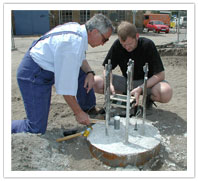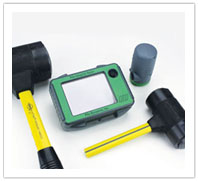Pile Integrity test is carried out to determine whether the structure is free from major cracks and discontinuities. Also known as Pile Integrity test, is based on wave propagation theory.  When a light impact is applied to a pile it produces a low strain. The impact produces a compression wave that travels down the pile at a constant wave. Changes in cross sectional area – such as a reduction in diameter – or material – such as a void in concrete – produce wave reflections.
When a light impact is applied to a pile it produces a low strain. The impact produces a compression wave that travels down the pile at a constant wave. Changes in cross sectional area – such as a reduction in diameter – or material – such as a void in concrete – produce wave reflections.
Applications
- Presence of necking or bulging in concrete can be obtained.
- Presence of major discontinuities and cracks can be assessed.
- It can be used for checking the quality of uniformity of concrete.
 Codes
Codes
ASTM – D 5882 – 00, 07
Methodology
The test method is performed with a hand held hammer, a sensitive accelerometer and thePile Integrity Tester. The accelerometer is attached to the top of the pile, and then a compressive wave is generated by tapping the pile head with a hammer. When the downward compression wave encounters a change in cross section or in concrete quality, it generates an upward tension wave that is later observed at the pile top. The velocity recorded along with the subsequent reflections from the pile toe or pile discontinuities are graphically displayed.
Limitations
- The test produces no information regarding the pile capacity, and gives only limited information about the concrete quality.
- For the test to be effective, the top of the pile should consist of clean concrete and should be levelled. Testing a pile with a head which was not properly prepared may yield misleading results.
- The accuracy of the length determination depends on the assumed wave velocity. This factor, which depends on the grade and age of the concrete, varies from pile to pile and may cause an error of the order of 10 percent.
- The reflected wave is influenced by changes in both the cross-section and friction along the skin. These two factors can be separated only if adequate information is available regarding the soil profile and if a reasonable number of piles is tested.
- The wave travelling along the pile loses energy as a result of skin friction. This may happen when the length exceeds 20 to 40 diameters, depending on the amount of friction.
- Since a serious defect or discontinuity will fully reflect the wave, this methods provides no information regarding lower levels. It also cannot distinguish between a large cavity and a hair-crack.

